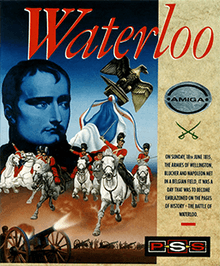Waterloo (video game)
Waterloo is a battle strategy game by PSS for MS-DOS, Atari ST, Amiga and Acorn Archimedes. It was released in the U.K. by Mirrorsoft in 1989 and in the U.S. by SSI in 1990.
| Waterloo | |
|---|---|
 | |
| Developer(s) | Personal Software Services |
| Publisher(s) | |
| Designer(s) | Peter Turcan |
| Platform(s) | MS-DOS, Amiga, Atari ST, Acorn Archimedes |
| Release |
|
| Genre(s) | Wargame |
| Mode(s) | Single-player |
Overview
The player takes the role of either Wellington or Napoleon at the Battle of Waterloo. The battle may be played with the historical orders or custom orders. It is a turn-based strategy game.
The 100-page manual provides historical and military background to the battle as well as gameplay information. A fold-out map of the battlefield and initial dispositions of units is also provided.
Gameplay
The game was innovative in being played from the point of view of the commander, with the battlefield rendered in simple three-dimensional perspective rather than the overhead view traditionally typical of battlefield strategy games. This means that the player's knowledge of the progress of the battle is limited to what he can see with his own eyes and the reports of subordinates. The player may move around the battlefield to better observe events, but risks death or capture if he approaches too close to the front.
The player is not permitted to micromanage the movements of individual units, as these are not under his direct command; instead he must give orders to subordinate commanders who interpret them according to their own judgement. A subordinate commander will ignore an order he considers unfeasible.
Orders are issued using natural language commands reminiscent of adventure games. For example,
- "D'Erlon, at 1 15 pm order Donzelot defend the hills 1 mile south of you"
- "Lobau, transfer your cavalry to Reille"
- "Drouot, at 6 30 pm give support to Reille, D'Erlon and Milhaud"[1]
Orders take time to arrive at their destinations, as do combat reports sent by subordinates to the player. Messengers may also be killed or captured. This means that units remote from the commander may not receive orders in time, while units engaged in combat may not receive them at all.
The game begins at 11:30 am and ends at 9:30 pm, when the results are assessed. The computer then decides if the player has been defeated, is victorious, or if the result is inconclusive.
Reception
Computer Gaming World's reviewer, who studied Waterloo at the United States Army Command and General Staff College, in 1990 gave the game three stars out of five and described it as "fascinating, albeit frustrating". He stated that Waterloo's unusual, three-dimensional ground perspective and resulting uncertainty over the battle's progress helped make the game the most accurate of the ten simulations of the battle he had played. The reviewer approved of the graphics but noted that the frequent screen updates ran slowly on older computers, and criticized the lack of any audio.[2][3] In a 1993 survey of pre 20th-century strategy games the reviewer gave the game three-plus stars out of five, calling it "fascinating though frustrating".[4]
References
- Game manual.
- Brooks, M. Evan (July–August 1990). "Waterloo / The British Take Us Back To The Battlefield". Computer Gaming World. p. 40. Retrieved 16 November 2013.
- Brooks, M. Evan (October 1990). "Computer Strategy and Wargames: Pre-20th Century". Computer Gaming World. p. 11. Retrieved 16 November 2013.
- Brooks, M. Evan (June 1993). "An Annotated Listing of Pre-20th Century Wargames". Computer Gaming World. p. 136. Retrieved 7 July 2014.